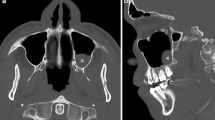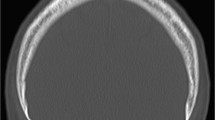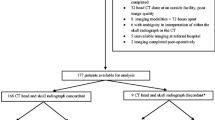Abstract
The purpose of this paper is to determine the necessity of a dedicated facial bone/orbital computed tomography (CT) scan for fracture surveillance in patients who have suffered blunt head trauma and whose routine nonenhanced head CT scan is negative. It is based on a retrospective review of 115 patients presenting to the Emergency Department at a level I trauma center after blunt head trauma. Included patients underwent both a nonenhanced head CT scan and a dedicated facial bone or orbit CT. Standard nonenhanced head CT protocol was followed for each patient as per department protocol. A positive head CT scan is defined to include either an air–fluid level within the paranasal sinuses or fracture of the maxillary, orbital, or zygomatic osseous structures. A negative scan demonstrates none of these findings. Intracranial/parenchymal pathology was not evaluated in this study. Sixty-five of the 115 patients had a negative head CT scan as defined above. Of these 65 patients, none subsequently had a positive facial bone or orbit CT scan. The sensitivity and negative predictive values of a negative routine nonenhanced head CT scan for fracture surveillance are both 100%. In the setting of blunt trauma, a negative nonenhanced head CT scan precludes the need for a dedicated facial bone or orbital CT scan in the evaluation for orbital, maxillary, or zygomatic fractures. This saves the patient unnecessary radiation exposure, health care costs, and time spent in the emergency radiology department.





Similar content being viewed by others
References
Kraus JF, Black M, Hessol N, Ley P, Rokaw W, Sullivan C, Bowers S, Knowlton S, Marshall L (1984) The incidence of acute brain injury and serious impairment in a defined population. Am J Epidemiol 119:186–201
Lambert DM, Mirvis SE, Shanmuganathan K, Tilghman DL (1997) Computer tomography exclusion of osseous paranasal sinus injury in blunt trauma patients: the “clear sinus” sign. J Oral Maxillofac Surg 55:1207–1210
Thai KN, Hummel RP III, Kitzmiller WJ, Luchette FA (1997) The role of computed tomographic scanning in the management of facial trauma. J Trauma 43:214–217
McGowan DA, Baxter PW, Jacqueline J (1993) The maxillary sinus and its dental implications. Wright, Oxford, p 18
Author information
Authors and Affiliations
Corresponding author
Rights and permissions
About this article
Cite this article
Lewandowski, R.J., Rhodes, C.A., McCarroll, K. et al. Role of routine nonenhanced head computed tomography scan in excluding orbital, maxillary, or zygomatic fractures secondary to blunt head trauma. Emergency Radiology 10, 173–175 (2004). https://doi.org/10.1007/s10140-003-0323-2
Received:
Accepted:
Published:
Issue Date:
DOI: https://doi.org/10.1007/s10140-003-0323-2




